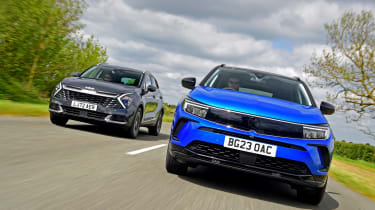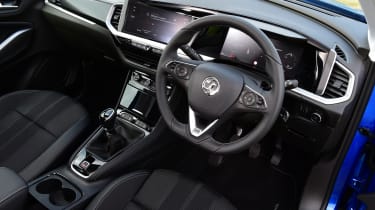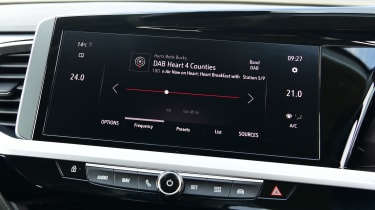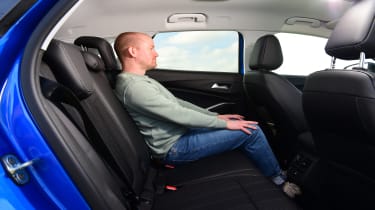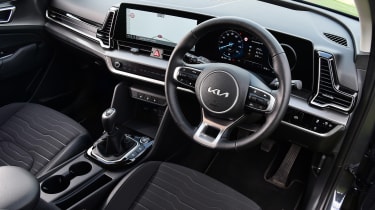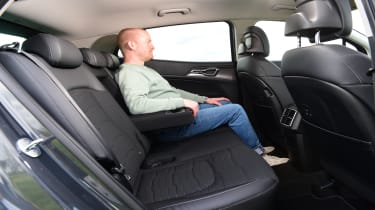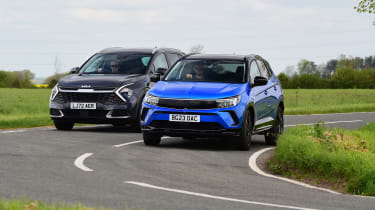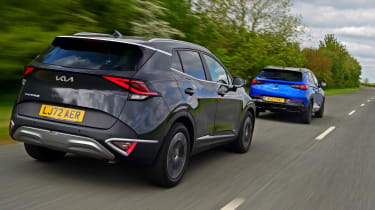Vauxhall Grandland vs Kia Sportage 2023: twin test review
Vauxhall has tweaked the Grandland to provide a stronger rival to the big-selling Kia Sportage. We find out if it has succeeded
Scan the UK sales charts of the past few decades, and you’ll see that Vauxhall has consistently ranked as one of the most popular brands. It produces the type of cars that people need; from the compact Corsa, to the striking yet practical Astra. The British company has followed the current SUV trend, too, with the Grandland.
So far in 2023, Vauxhall ranks seventh overall, and one of the brands ahead of it is Kia, a marque that, even 10 years ago, nobody would have expected to overtake its rival. Kia’s Grandlandrival is the Sportage, and it’s the fourth best-selling car in the UK so far in 2023.
Vauxhall has tweaked the Grandland this year in a bid to compete, but which is best overall? Plus, to examine why Kia’s sales are so strong, we’ve compared other models from each firm to see where their respective strengths lie.
Vauxhall Grandland 1.2 GS | Kia Sportage ‘3’ 1.6 T-GDI | |
Price: | £31,730 | £32,560 |
Powertrain: | 1.2-litre 3cyl turbo, 128bhp, six-speed manual | 1.6-litre 4cyl turbo, 148bhp, six-speed manual |
0-62mph: | 10.4 seconds | 9.9 seconds |
Test efficiency: | 39.1mpg/8.6mpl | 39.8mpg/8.8mpl |
CO2: | 140g/km | 154 g/km |
Annual VED: | £180 | £180 |
Vauxhall Grandland
Since its release in 2017, the Vauxhall Grandland has quietly gone about its business admirably well, without ever quite offering the wow factor to top the class. Can this new model, which in GS trim and with a 1.2-litre turbocharged petrol engine starts at £31,730, be enough for it to make that final step?
Tech highlights
In February 2022, UK sales began for a revised Grandland model, which dropped the previous X off its name, but more significantly gained a restyled exterior and overhauled interior design. Mechanically, it was identical to the pre-facelift car, using the same EMP2 platform, the same engine line-up and the same chassis settings.
For 2023, however, Vauxhall’s engineers have turned their attention to the third of those areas. Across the range, the Grandland gets revised suspension settings, which are designed to increase the damping force over large bumps, but soften the response over harsher lumps – moves which the brand claims have improved comfort over poor surfaces. There are also tweaks to the steering set-up, which Vauxhall says has been recalibrated for a quicker, more accurate response.
The 1.2-litre three-cylinder turbo petrol engine we have here is unchanged. It produces 128bhp and delivers 230Nm of torque to the front wheels.
Safety: When the Grandland was assessed by Euro NCAP, it achieved a maximum five-star rating. This was back in 2017, however, and NCAP’s testing now marks down a lack of active safety tech more strictly. The GS spec we’re evaluating isn’t lacking in that area, though; adaptive cruise control, lane-departure warning and forward-collision alert are all fitted as standard.
On the road
The Grandland’s road manners are everything you need for a family car. It’s not outstanding in any one area, but it’s comfortable, easy to drive and delivers decent performance.
Around town: One of the first things that you notice when getting behind the wheel of the Grandland is that the suspension set-up is a little softer than in some rivals. Combined with the modestly sized wheels of this test car, it results in a fairly soothing ride, which doesn’t crash harshly into potholes or speed bumps. Light steering and a fairly tight turning circle mean that the Vauxhall is simple to drive around town.
A & B-roads: A 1.2-litre engine in a car of this size needs to rely quite heavily on the turbocharger to make progress. Fortunately, peak torque arrives at 1,750rpm, so it pulls quite strongly from low revs. But work it beyond that and it struggles towards the upper reaches of the power band; at this point it begins to sound strained, too. It’s best, then, to avoid working it too hard, because otherwise the three-cylinder unit remains hushed.
On a twisty road the Grandland rolls a little bit around the turns, with a slight nose-heavy balance. Although heavy braking causes quite a lot of dive, the car remains stable and composed enough the rest of the time. Vauxhall’s revised steering set-up is less successful, though. It offers very little self-centering, which feels a little odd.
Motorway: While that engine makes a gruff noise under hard acceleration, slot it into sixth and the engine is hushed at a high-speed cruise. Road and wind noise are fairly well suppressed, and that soft ride continues to contribute to the relaxing feel.
Ownership
Interior quality took a big step forward with the Grandland’s mid-life facelift, although the biggest reason for the change was to accommodate the new and improved in-car technology. Everything inside feels sturdy, but the glossy black plastic across the dash doesn’t look like the most robust surface to cope with family life.
The driving position has lots of adjustment, but the dash feels quite high and imposing, so unless you jack the seat higher up than you might usually choose to, the view out isn’t that great. The seats are supportive, but are a little firmer than the Kia’s.
In the 2022 Driver Power customer satisfaction survey, Vauxhall didn’t fare well as a brand overall, finishing 19th overall in the standings. That’s still an improvement on its performance the previous year, and perhaps more encouragingly for this contest, the Grandland itself finished in 24th in the individual model rankings – inside the top third overall, and comfortably the highest-ranking Vauxhall. The Grandland comes with a three-year, 60,000-mile warranty as standard, which is below the class standard – and less than half of the duration you get with the class-leading Kia.
When it comes to depreciation, there’s little in it. Indeed, the Grandland is ever-so-slightly better, holding 55.9 per cent of its original value after three years. years. The Kia manages 55.3 per cent.
Storage: Compared with the most modern family SUVs, the Grandland’s storage spaces don’t feel like they were planned with current technology in mind. The central bin at the base of the dashboard – the one where most people would tend to keep their smartphone – is too small for the latest devices, so it’ll need to be kept in the central cubby between the seats. Other spaces are compromised, too; the door pockets are small and the glovebox is tiny, with the fuse box hogging most of the space.
Practicality
Whether you’re in the back or loading items into the boot, the Grandland offers plenty of space. It’s not quite a class-leader in this respect, but there’s nothing major to mark it down, either.
Rear space: There’s plenty of space in the back of the Grandland, so even tall adults won’t moan about a shortage of headroom. They could complain about the seat bases, though; they’re relatively short, so longer-legged occupants might find the under-thigh support somewhat lacking.
Boot: At 514 litres, the Grandland’s boot is more than roomy enough for most needs. When you do need more space, the seat backs can drop down – and they go almost flat to expand the total volume to 1,652 litres. Although the back seats only split 60:40, there is a central ski hatch, so that you can carry long, thin items while still catering for two in the back.
What to buy?
Which engine and trim we’d choose
- Engines: The 1.2-litre petrol engine is available with a six-speed manual gearbox or, for £1,500 more, an eight-speed auto. There’s also a 1.5-litre diesel (auto only), plus a choice of two plug-in hybrids with 222bhp and 296bhp.
- Trim: The Grandland family now has three clear trim levels. The line-up kicks off with Design and is topped by the Ultimate, with our GS in between them. The most potent PHEV comes in GSE trim.
- Options: The only significant GS-spec option is the Winter Pack, which adds a heated steering wheel and front seats.
- Our choice: Of all of the variety in the range, we think our GS petrol is a sweet spot.
Kia Sportage
As with the Grandland, we’re testing the Kia Sportage in its middle trim level, known simply as 3. When paired with a petrol engine and a manual gearbox, it’s slightly more expensive than its rival; its £32,560 price tag is £830 higher.
Tech highlights
In a similar vein to the Grandland, the Kia Sportage uses a platform that is shared with a range of other models worldwide. Here in the UK, the Sportage’s Hyundai Group N3 architecture is also used by the Hyundai Tucson and the largest SUV in Kia’s UK line-up, the Sorento. It means that the Sportage can be offered with three levels of electrification: a mild hybrid, a full hybrid and, as with the Grandland, a plug-in hybrid.
The entry-level power unit we’re testing here relies purely on combustion power. The petrol unit has an extra 399cc over the Vauxhall and a fourth cylinder, thanks to its 1.6-litre in-line configuration. As with its rival, a turbocharger boosts torque at low revs, and the 250Nm peak arrives at 1,500rpm, which is 250rpm sooner than the Vauxhall’s 230Nm peak, and lasts all the way up to 4,000rpm.
The result is a 0-60mph time of 9.9 seconds; Vauxhall quotes a 0-62mph time that’s just half a second slower, so on paper there isn’t much in it. The Kia’s extra power is offset by a kerbweight of 1,526kg, which is 95kg more than the Vauxhall’s.
Safety: The Sportage was assessed by Euro NCAP in 2022, and it chalked up a maximum five-star rating. However, when it comes to standard safety kit, it isn’t quite as well stocked as the Grandland. Blind-spot monitoring is only fitted as standard on the top-spec GT-Line S model, as is a parking collision avoidance system. Adaptive cruise control, plus a self-steering Highway Drive Assist set-up, are only available on Sportages fitted with an automatic gearbox.
On the road
In most respects, the margins between the way these two models drive are very narrow. But the Kia holds a slim advantage in one or two areas, even if engine refinement is disappointing when compared with the Vauxhall.
Around town: There’s not much in it when it comes to ride, but the Kia is slightly softer. The clutch feels unnaturally light, while the throttle is very sensitive in the first few millimetres of its travel. Combine these elements, and it takes some practice to get the hang of pulling away without revving the engine too eagerly.
A & B-roads: Revs are something you want to avoid in the Sportage. Not because of the performance – the four-cylinder unit is more willing than the Grandland’s 1.2 when you accelerate hard – but because the 1.6-litre petrol engine sounds unpleasant. There’s a diesel-like roughness to its delivery. The six-speed shift is less rubbery than the Vauxhall’s, though.
The Kia has a similar soft bounciness to the Grandland on a B-road; it feels as if its centre of gravity is higher through the turns, but it seems lighter on its feet, too, despite a higher kerbweight. The steering is one of the key areas where the Kia feels more satisfying than the Vauxhall. The weighting is more natural as you guide the Sportage into a turn, and the rack feels precise enough for you to trust in what the car is doing.
Motorway: At higher speeds, the pair remain closely matched. The muted road rumble is almost indistinguishable between the two rivals, and wind noise is similarly well contained. The Kia’s straight-line stability is fine, and the engine settles down at a cruise. There’s enough low-down torque for you to leave the car in sixth and not worry about downshifts on inclines.
Ownership
The Kia’s cabin feels like a step up from the Vauxhall’s both in terms of its contemporary design and its perceived build quality.
It feels more expensive, and the parts of the car you touch most often, such as the steering wheel and the buttons on it, feel better to hold. There’s loads of adjustment in the steering wheel (but a slightly smaller range of fore/aft movement in the front seat), so it’s very easy for a wide range of body types to get comfortable.
Then there’s the visibility. While the driver’s view is still a little obstructed over the shoulder, as in the Vauxhall, the lower dashboard line means you feel less cocooned in the driver’s seat, so you get a better view of the road ahead.
The swoopy design neatly accommodates the pair of large digital displays, yet also does a reasonable job of combining touch-sensitive functionality and physical controls. A slim touch panel serves a dual purpose. In one mode, it operates all of the climate functions (the temperature adjustment is controlled by small physical dials), while a screen press changes it to a bank of shortcut keys for the infotainment system. At this point what was previously a temperature knob now adjusts the volume of the sound system. Most of our testers find the system quite intuitive to use, but others would prefer more real buttons.
Storage: The Sportage fares much better than the Vauxhall for holding a variety of small items. A wide, open shelf ahead of the gearlever is big enough to take even large smartphones, and devices can be topped up via the USB-C ports.
The central cup-holders are wide and deep, and the armrest behind hides another deep bin. The glovebox is a decent size (although it needs to be to house an enormous owner’s manual) and the door bins are able to hold a one-litre bottle. There are further cup-holders in the back, too.
Practicality
The Vauxhall is certainly roomy, but the Kia is even better – especially in the boot.
Rear space: The passenger room is impressive, beating the Grandland in most areas, if only by small margins. On top of that, the backrest can be adjusted for angle, and unlike in the Vauxhall, you get a fold-down centre armrest.
Boot: While the Grandland’s boot will be large enough for most, the Kia’s is even bigger – the 591-litre space beats the Vauxhall by a clear 77 litres. Not only that, but the load lip is also 65mm lower, so it’s easier to lift bulky items on board, while the floor is level with the boot lip. Drop the back seats – made easy by large levers in the boot – and you get a clear, flat volume that measures 1,780 litres, which is 128 litres more than you get in the Grandland. A 12-volt socket makes it possible to charge items, too.
What to buy?
Which engine and trim we’d choose
- Engines: Mild hybrid, full hybrid and plug-in hybrid versions are all available with automatic gearboxes. The HEV and PHEV both drop the 0-60mph time to less than eight seconds.
- Trim: 2, GT-Line, 3, and GT-Line S are the four choices, but the top-spec model can’t be paired with this engine and gearbox. Settle for 17-inch wheels, cloth seats, and no seat heating, and the base 2 dips well below the £30k mark, at £28,360.
- Options: Beyond paint shades, the only extras come from the accessories range. You can even add bonnet stripes.
- Our choice: This mid-range 3 model has plenty of kit to feel upmarket enough for most.
Results
Which car comes out on top?
Winner: Kia Sportage
Once again, the Sportage proves why it’s such a strong performer. There really is no glaring weakness in its game, with pretty much any quality you can think of rating from above average to class leading.
There’s loads of space inside, it’s comfortable and decent to drive, and it’s more powerful yet slightly more frugal than the Grandland. With a little more star quality than its rival and costing an almost identical amount to run over three years (or being far cheaper to lease), then it takes a deserved win.
Pros | Cons |
Spacious cabin | Rough engine note |
Solid ride/ handling balance | Less standard safety kit than Vauxhall |
Frugal engine | High insurance costs |
Infotainment tech |
Runner Up: Vauxhall Grandland
It’s the runner-up here, but the Vauxhall Grandland is still a very capable car. We like the space inside and the standard safety tech, the running costs are reasonable, and the improvements to the suspension – if not the steering – are generally positive.
The trouble is that against such a strong rival, the Grandland at best matches the Sportage in some areas, but elsewhere the Kia just edges it. Still, it’s pretty accomplished against one of the best models in the class.
Pros | Cons |
Improved ride | So-so performance |
Refined engine | Steering feedback |
Spacious cabin | Best finance deals won’t work for all |
Standard safety tech |
Kia vs Vauxhall: Through the range
The Sportage takes the honours in this week’s real-world road test, but how do other models in each brand’s line-up stack up against their rivals?
Supermini: Rio vs Corsa
The biggest hit in the Vauxhall range is undoubtedly the Corsa. The long-standing nameplate has scaled the heights of the UK’s best-seller charts, and so far in 2023, it’s made it right to the top. It’s not hard to see why it’s such a popular choice. While there are certain supermini rivals that are better in selected areas, the Corsa consistently performs well across the board without any obvious drawbacks. It’s easy to drive, the ride is better than in many other superminis, and the engines – including the same 128bhp 1.2-litre petrol in our Grandland test car – offer efficiency and punchy performance. While Kia has a very strong and relatively new line-up, the Rio is among its oldest cars, having made its debut in 2016. That age is telling beside the Corsa, and not just in terms of the design.
The ride lacks sophistication beside its newest rivals, with a firm response that’s in contrast to the Corsa’s. The cabin is logically laid out, if looking a little dated in some areas. But the 325-litre boot is generous for the class standard, and beats the Corsa by 16 litres. Our Choice Vauxhall Corsa. Why? If you’re looking for a bargain supermini, then the Rio is a good option. But if you spend a little more, the Corsa offers a more sophisticated drive, with stronger engines and a more contemporary feel than the Kia.
Family: Ceed vs Astra
The Ceed has always majored on strong value for money, and thanks to a £2,000 deposit contribution from Kia, that remains the case. It’s among the sharpest- handling in the class, and kit levels are strong.
The Astra is competitively priced, too, especially if you take advantage of the same zero per cent finance deal that’s offered on the Grandland. It’s more expensive than the Ceed on matching finance terms, but the Astra justifies it with better refinement, a bigger boot and more modern in-car tech. Crucially, though, Vauxhall offers buyers much more choice. While the Ceed only comes with a 1.5-litre turbo petrol (and is a manual only, unless you stretch to the top-spec GT-Line S), Vauxhall offers the Astra with petrol, diesel and PHEV powertrains, and there’s a full-EV variant on the horizon. Our Choice
Vauxhall Astra. Why? These cars are two of our favourites in a very competitive family hatchback class, but the Vauxhall’s range of powertrains, plus the fact that the Ceed is starting to feel a little dated, is why the Astra is our choice.
SUV: Stonic vs Crossland
While both are similar in length, the Crossland is 85mm taller than its Korean counterpart. This means you get a higher driving position and more headroom inside. At 410 litres, the Vauxhall’s boot is also a useful 58 litres larger than the Kia’s. To counter this, the Stonic has a sportier look – something which also transfers to the way it drives. Its suspension is firmer and its handling is sharper than the more comfortable Crossland. Both get a choice of three-cylinder turbocharged engines, but the Crossland’s units have more torque.
Thanks to a £1,500 deposit contribution and a competitive rate of interest, the Kia is much cheaper on a PCP. A top-spec Stonic GT-Line S less costs £265 a month on a three-year deal with a £5,000 deposit – £30 a month less than an entry-level Crossland. Our Choice
Kia Stonic. Why? The Crossland beats the Stonic in several areas, thanks to its superior comfort, stronger engine and more spacious cabin. But despite some flaws, the Kia’s value for money is impossible to ignore, which is why it wins here.
EV: Niro EV vs Mokka Electric
The Niro EV is in its second generation, although the original’s powertrain was so strong that the specs remained largely unchanged. A 201bhp electric motor drives the front wheels, powered by a 64.8kWh battery with a WLTP range of up to 285 miles. A disappointing maximum charging rate of 72kW is one of the few downsides. Otherwise it’s a spacious, comfortable family hatch with a fairly relaxing ride and slick in-car tech.
Vauxhall’s Mokka Electric feels very grown up to drive, with decent refinement and build quality. At 100kW, it can charge faster than the Kia, but you get less power (134bhp), less range (209 miles) and less space inside for a similar amount of money. Our Choice Kia Niro EV. Why? In isolation, the handsome Mokka EV is a compelling choice. The Vauxhall drives better than its combustion counterparts yet is just as practical. But the Kia has an edge in several key areas, so it’s a better option for similar cash.
Figures
Vauxhall Grandland 1.2 GS | Kia Sportage 1.6 T-GDI 3 | |
Petrol or Diesel? | Petrol | Petrol |
MPG | 39.1 | 39.8 |
Fuel Price (£) | £1.46 | £1.46 |
P11D value | £31,420 | £31,860 |
Fill up | £77.54 | £77.54 |
On the road price/total as tested | £31,230 / £31,930 | £32,560 / £33,210 |
Residual value (after 3yrs/36,000) | £17,467 / 55.9% | £17,999 / 55.3% |
Depreciation | £13,763 | £14,561 |
Annual tax liability std/higher rate | £2,073.72 / £4,147.40 | £2,230.20 / £4,460.40 |
Annual fuel cost (10k/20k miles) | £1,701 / £3,402 | £1,671 / £3,342 |
Ins. group/quote/VED | 17 / £682 / £180 | 18 / £797 / £180 |
Service costs (3 years) | £720 | £539 |
Length/wheelbase | 4,477 / 2,675mm | 4,515 / 2,680mm |
Height/width | 1,609 / 1,906mm | 1,645 / 1,865mm |
Powertrain | 3 cyl in-line / 1,199cc | 4cyl in / 1,598cc |
Peak power | 128 / 5,500 bhp / rpm | 148 / 5,500bhp / rpm |
Peak torque | 230 / 1,750 Nm / rpm | 250 / 1,500-4,000Nm / rpm |
Transmission | Six-speed man/fwd | Six-speed man/fwd |
Feul tank capacity / spare wheel | 53 litres / dealer-fit option | 54 litres / repair kit |
Boot capacity (front / seats up/down) | 514 / 1,652 litres | 591 / 1,780 litres |
Kerbweight/payload/towing weight | 1,431 / 499 / 1,400kg | 1,526 / 559 / 1,650kg |
Turning circle | 10.7 metres | 10.9 metres |
Basic warranty/recovery | 3yrs (60k) / 1yr | 7 yrs (100,000k) / 1 yr |
Driver Power manufacturer position | 19th / N/A | 3rd / 5th |
Euro NCAP: Adult/child/ped./assist/stars | 84 / 87 / 63 / 60 / 5 (2017) | 87 / 86 / 66 / 72 / 5 (2022) |
0-62mph/top speed | 10.4 secs / 122mph | 9.9* secs / 113mph (* 0-60mph) |
Auto Express economy / predicted range | 39.1 / 456 miles | 39.8 / 473 miles |
WLTP combined | 44.8mpg | 41.5mpg |
WLTP combined | 9.8mpl | 9.1mpl |
Actual/claimed CO2/tax bracket | 167 / 140g/km | 164/ 154g/km |
Number of airbags/Isofix points | Six / three | Six / two |
Parking sensors/camera | F&r / yes | F&r / yes |
Lane-keep assist/AEB | Yes / yes / yes | Yes / no / yes |
Climate control/adaptive cruise ctrl | Two-zone / yes | Two-zone / no |
Leather/heated seats | No / £600* / £600* (*part of winter pack) | Part / f&r / yes |
Metallic paint/LED lights | £600 / yes | £650 / yes |
Keyless entry & go/powered tailgate | Yes / no | Yes / no |
Sat-nav/digital dashboard/USBs | Yes / yes / two | Yes / yes / four |
Online services/wireless charging | Yes / no | Yes / no |
Apple CarPlay/Android Auto | Yes / yes | Yes / yes |
